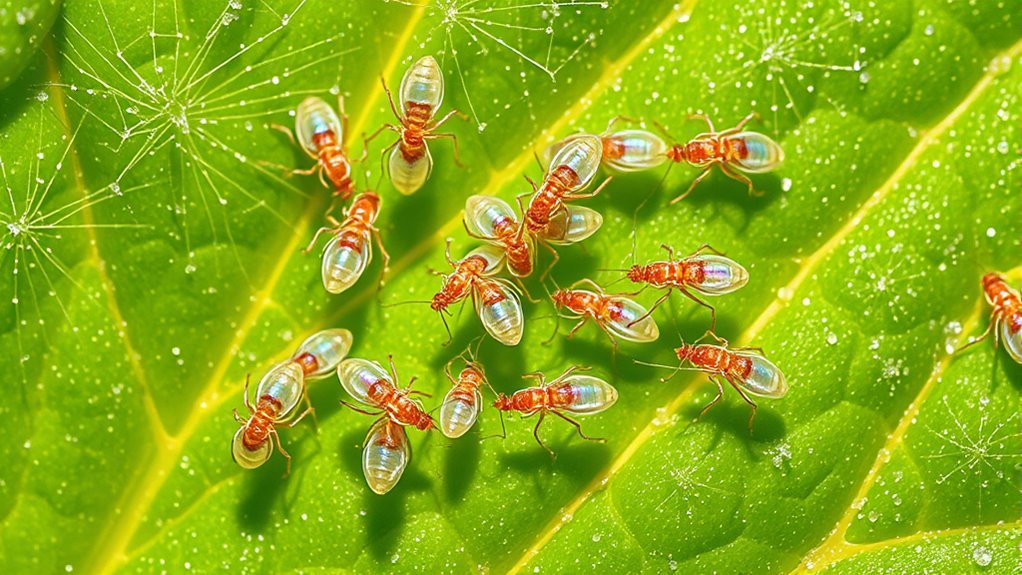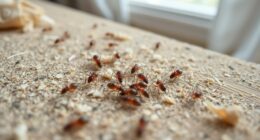Introducing predatory mites is a natural, eco-friendly way to manage spider mite infestations. Release them when pest populations start to rise, spreading them evenly across affected areas, especially under leaf surfaces. Guarantee environmental conditions like humidity and temperature are suitable to support their activity. Regular monitoring helps assess success and adjust if needed. If you want to learn more about effective strategies and tips, there’s much more to explore beyond this quick overview.
Key Takeaways
- Predatory mites naturally control spider mite populations by feeding on them, offering an eco-friendly pest management solution.
- Release predatory mites early in infestation for best results, ensuring proper distribution across affected plant areas.
- Maintain optimal environmental conditions like humidity and temperature to support predatory mite activity and survival.
- Avoid chemical pesticides that can harm beneficial mites and disrupt biological control efforts.
- Regularly monitor pest and predator levels to adjust release timing and density for effective management.
Understanding Spider Mites and Their Impact on Plants

Spider mites are tiny pests that can cause significant damage to your plants. When they feed, they puncture plant cells, which disrupts plant nutrition and weakens the overall health. This damage often leads to yellowing leaves, leaf drop, and stunted growth. Poor soil aeration can worsen the problem, as compacted soil limits root access to oxygen, making plants more vulnerable to pests. Healthy plants with good soil aeration and balanced nutrition are better equipped to resist spider mite infestations. Recognizing early signs of infestation, like fine webbing and speckled leaves, allows you to take action before damage becomes severe. Managing plant nutrition and maintaining soil health are essential steps in preventing spider mites from taking hold and causing extensive harm. Proper soil aeration enhances root health, making plants more resilient against pest attacks.
What Are Predatory Mites? An Overview
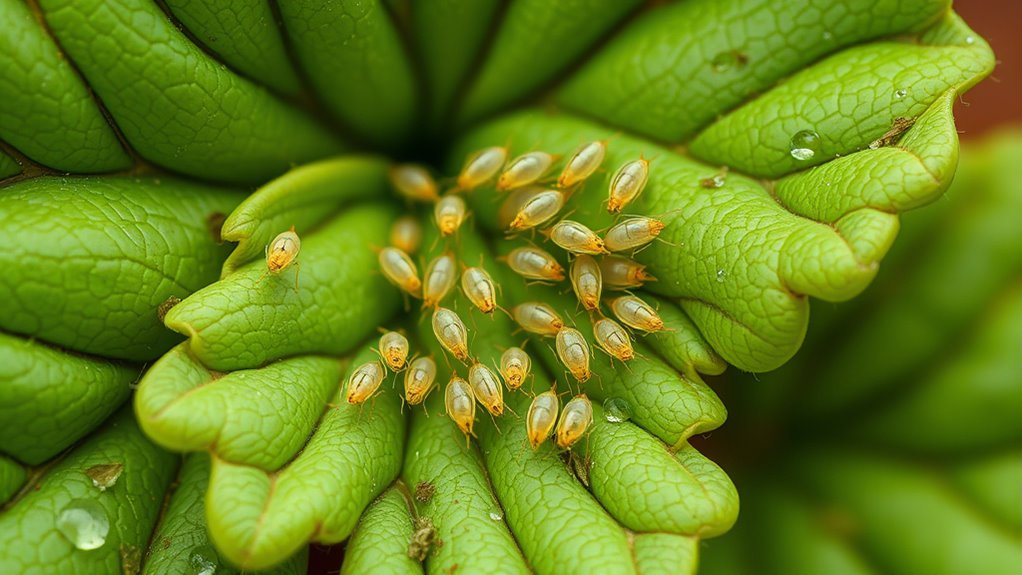
Predatory mites are beneficial insects that naturally help control pest populations like spider mites. These tiny creatures have specialized predatory habits that make them effective biological control agents. Their mite anatomy allows them to efficiently locate and feed on pest mites, often thriving in the same environments where spider mites are found. Predatory mites typically have a small, oval-shaped body with long legs that help them move quickly across plant surfaces. Their ability to adapt to various conditions and target specific pests makes them valuable allies in integrated pest management. Additionally, their effectiveness can be enhanced when used in conjunction with other well-being techniques such as proper plant care. By understanding their predatory habits and mite anatomy, you can better appreciate how these beneficial mites work to keep pest populations in check naturally.
How Predatory Mites Naturally Control Spider Mite Populations

Because of their specialized feeding habits, predatory mites actively seek out and consume spider mite populations, effectively reducing their numbers. Their predatory mite behavior is driven by the ability to detect spider mites through chemical cues and movement, making them efficient natural control agents. Predatory mites prefer specific mite habitat preferences, such as the undersides of leaves and areas with high humidity, where spider mites thrive. They are naturally attracted to infested plants, ensuring they target the problem directly. As they hunt, predatory mites continually adapt their behavior to locate and consume spider mites quickly. This natural control process helps keep spider mite populations in check without the need for chemical interventions, making predatory mites a sustainable and eco-friendly solution for pest management. Cookies and privacy play a role in tracking user interactions that can help improve their effectiveness.
Benefits of Using Predatory Mites Over Chemical Pesticides
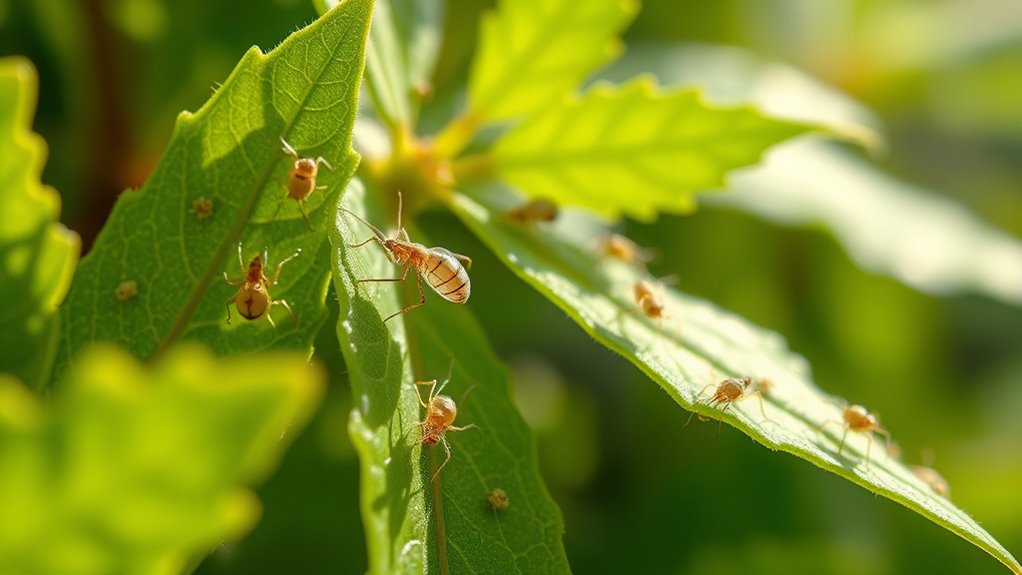
Using predatory mites offers significant advantages over chemical pesticides, especially when it comes to safety and environmental health. Chemical pesticides can lead to pesticide resistance, making pests harder to control over time. In contrast, predatory mites naturally suppress spider mite populations without encouraging resistance. They also reduce the environmental impact, as they don’t contaminate soil, water, or air like chemicals do. Pesticides often harm beneficial insects and pollinators, but predatory mites target only their pests, leaving other beneficial organisms unharmed. Additionally, using predatory mites supports sustainable farming practices by promoting a balanced ecosystem. Biological control methods like predatory mites help maintain healthy gardens without relying on chemicals. Overall, they provide a safer, eco-friendly alternative to chemical pesticides, helping you manage pests effectively while protecting your garden’s health and biodiversity.
Selecting the Right Predatory Mite Species for Your Garden

Choosing the right predatory mite species for your garden is essential to effectively control spider mites without harming beneficial insects. To do this, consider the mite habitat—some predatory mites thrive in dry, hot conditions, while others prefer humid environments. Understanding predatory mite diversity helps you select a species suited to your garden’s specific conditions. For example, Phytoseiulus persimilis works well on greenhouse plants with high humidity, while Neoseiulus californicus adapts to drier outdoor settings. Matching the mite’s habitat preferences with your garden’s environment ensures better survival and control. Evaluating your garden’s microclimate and plant types guides your choice, maximizing predatory mite effectiveness and promoting a balanced, healthy ecosystem. Additionally, considering vetted product options can help you find reliable predatory mite sources tailored to your needs.
How to Introduce Predatory Mites Effectively

To introduce predatory mites successfully, you need to time the release when spider mite populations are beginning to grow. Use the right release density to guarantee enough mites are present to control the pests without waste. Applying the mites with effective techniques, like dispersing them evenly across affected areas, helps maximize their impact. Ensuring proper timing and release methods can significantly improve the success of biological control efforts.
Proper Release Timing
Timing is crucial when releasing predatory mites for spider mite control; introducing them too early or too late can reduce their effectiveness. To guarantee success, consider the timing considerations carefully. Release frequency should match the level of mite infestation, with more frequent releases during rapid population growth. Typically, releasing mites when spider mite populations first appear gives them the best chance to establish and control pests before they spread. Avoid waiting too long, as heavily infested plants may require multiple releases or integrated strategies. Monitor mite populations regularly to determine the ideal timing for releases. Proper timing maximizes predatory mites’ impact, reduces pest numbers efficiently, and helps maintain a balanced ecosystem in your garden or greenhouse. Additionally, understanding the life cycle of predatory mites can improve the success rate of biological control efforts.
Optimal Release Density
Releasing the right number of predatory mites is key to establishing effective control over spider mite populations. An ideal release density depends on factors like the size of your infested area and mite migration patterns. To maximize success, consider the genetics of the predatory mites, ensuring they are well-adapted to your environment. Proper release rates prevent under- or overpopulation, which can hinder control efforts. Monitoring mite movement helps determine if additional releases are necessary. Adjust your strategy based on how quickly mites migrate and reproduce. Additionally, understanding mite behavior can help optimize release timing and placement for better pest management.
Effective Release Techniques
Introducing predatory mites effectively requires careful handling to guarantee they adapt quickly and begin controlling spider mites promptly. To maximize their predatory behavior, release mites when environmental conditions are ideal—ideally in the early morning or late afternoon. Distribute them evenly across infested areas, ensuring they reach the underside of leaves where spider mites thrive. Use releases in patches to encourage mite reproduction and establishment. Avoid overcrowding, which can hinder predatory behavior, and ensure the environment isn’t too dry or hot, as these conditions can reduce mite activity. Proper release techniques help mites settle in and reproduce efficiently, boosting their population and effectiveness against spider mites. Additionally, maintaining proper humidity levels can significantly improve mite activity and survival for effective pest management. With careful application, predatory mites will establish quickly, providing ongoing natural pest management.
Tips for Maintaining a Healthy Environment for Predatory Mites
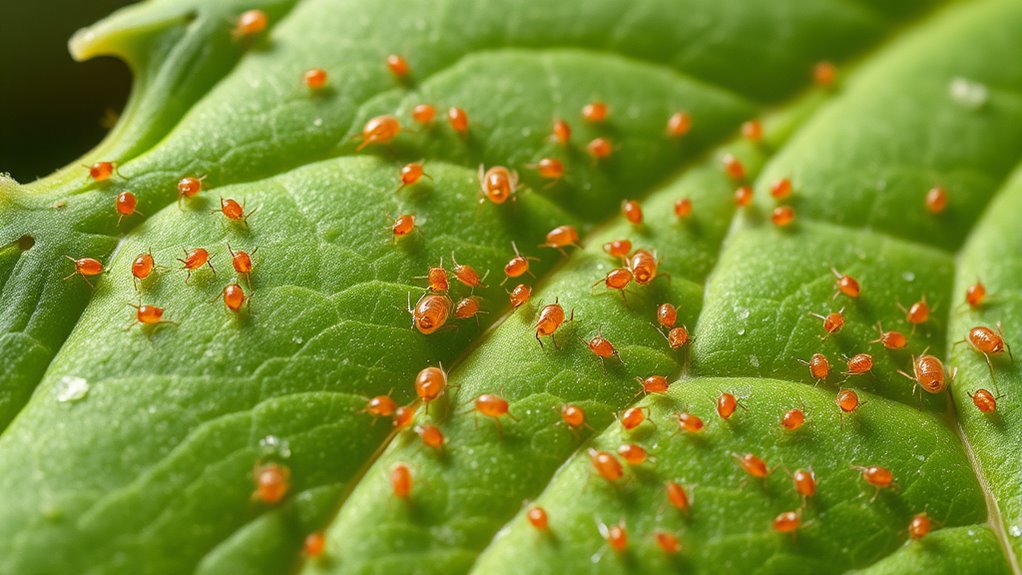
Maintaining a healthy environment is essential for the effectiveness of predatory mites in controlling spider mites. To support their survival, focus on improving soil health with appropriate soil amendments that enhance moisture retention and nutrient availability. Choose pest-resistant varieties of plants to reduce pest pressure and create a more stable habitat for the mites. Keep the area free of chemical pesticides that can harm beneficial insects. Guarantee proper watering to maintain humidity levels ideal for predatory mites. Providing a diverse plant environment encourages natural prey and offers hiding spots. Regularly monitor the environment to prevent extreme conditions that could stress the mites and reduce their effectiveness. Additionally, understanding that attention in creative practice can be applied to environmental management helps in creating conditions conducive to predatory mite success.
Monitoring and Evaluating the Success of Biological Control
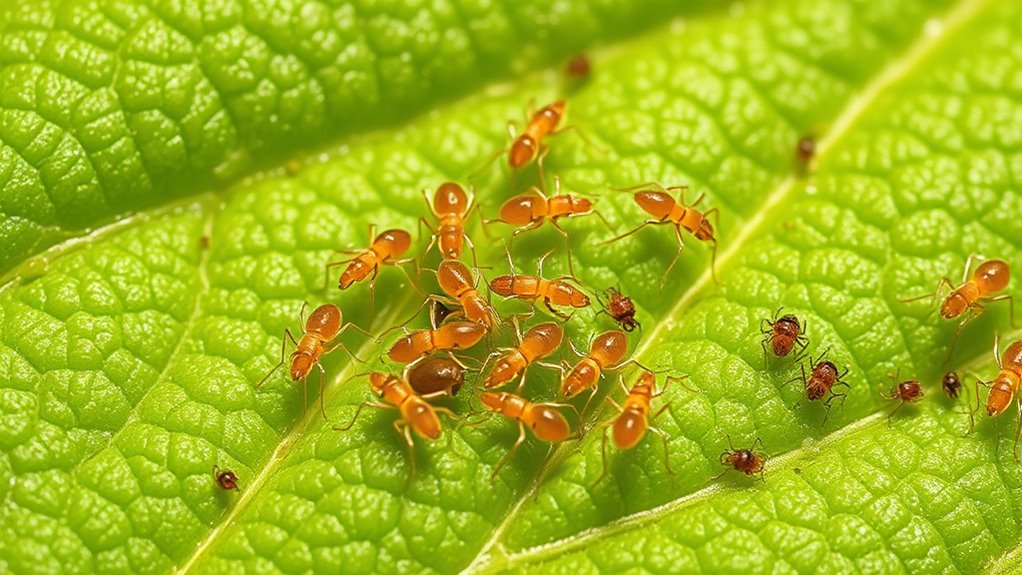
Monitoring and evaluating the success of biological control involves systematic observation of pest populations and predatory mite activity over time. Use monitoring techniques like visual inspections, sticky traps, and leaf sampling to track spider mite levels and predatory mite presence. Success indicators include a noticeable decline in spider mite numbers, increased predatory mite activity, and improved plant health. Regular assessments help determine if the predatory mites are establishing well and controlling pests effectively. Record your observations consistently to identify trends and make informed decisions about continuing or adjusting your control strategies. By closely monitoring these success indicators, you can guarantee your biological control efforts are on track and adjust your approach as needed for optimal pest management.
Common Challenges and Troubleshooting in Using Predatory Mites

Using predatory mites for spider mite control can sometimes present challenges, especially when environmental conditions or application methods are not ideal. One common issue is mite resistance, where spider mites adapt over time, reducing the effectiveness of predators. Environmental factors like temperature, humidity, and light can also hinder predatory mite survival and activity. If conditions are too dry or too hot, mites may not thrive, leading to poor control results. Additionally, improper application—such as uneven distribution or timing—can limit success. To troubleshoot, you should:
- Monitor environmental conditions closely
- Adjust application timing and methods
- Ensure proper humidity and temperature levels
- Rotate biological controls to prevent mite resistance
Addressing these challenges boosts your chances of successful spider mite management.
Frequently Asked Questions
Are Predatory Mites Safe for All Types of Plants?
You might wonder if predatory mites are safe for all plants. Generally, they have good plant compatibility, but some plants show mite sensitivity, which could be influenced by the mites’ presence. It’s important to check if your plants are compatible before releasing them. Usually, predatory mites target pests without harming your plants, but always monitor your plants closely to ensure they don’t cause any unintended issues.
How Quickly Do Predatory Mites Control Spider Mite Infestations?
You’ll see predatory mites control spider mite infestations relatively quickly, often within a week or two. The key is the release timing—you want to introduce them early, when mite populations are still low. Predatory mite speed varies based on conditions like temperature and humidity, but generally, they start reducing spider mite numbers fast, providing an eco-friendly and efficient solution to pest problems.
Can Predatory Mites Establish Themselves Permanently in My Garden?
You wonder if predatory mites can establish permanently in your garden. Their ability depends on your garden diversity and predatory mite lifespan. A diverse garden with plenty of food and habitat encourages their survival, making permanent establishment more likely. Predatory mites have a lifespan that supports ongoing control, but regular monitoring and habitat support are key to maintaining their presence long-term.
Do Predatory Mites Require Specific Environmental Conditions to Thrive?
Imagine your garden as a delicate dance floor where predatory mites perform best. They thrive in environments with the right humidity levels and temperature preferences, much like dancers needing perfect conditions to shine. Too dry or too humid, and they falter. Keep the humidity balanced and temperatures moderate, and your predatory mites will flourish, naturally controlling spider mites and maintaining a healthy, vibrant garden ecosystem.
Are There Any Risks of Predatory Mites Becoming Pests Themselves?
You might wonder if predatory mites could turn into pests themselves. While mite predation helps control spider mites, there’s little risk of the predators becoming pests. They typically target specific pests, and pest resistance is rare because predatory mites don’t feed on plants. However, it’s important to monitor their population to prevent any imbalance. Overall, introducing predatory mites is a safe, effective method with minimal risk of pest resistance or unwanted mite issues.
Conclusion
By choosing predatory mites, you’re taking a natural, eco-friendly approach to manage spider mites. With proper selection, introduction, and care, you can keep your plants healthy without relying on harmful chemicals. Remember, patience is key—”Rome wasn’t built in a day.” Stay vigilant, monitor your mites regularly, and you’ll create a balanced environment that naturally controls pests and promotes thriving plants. Your efforts will pay off with a healthier, pest-free garden.
